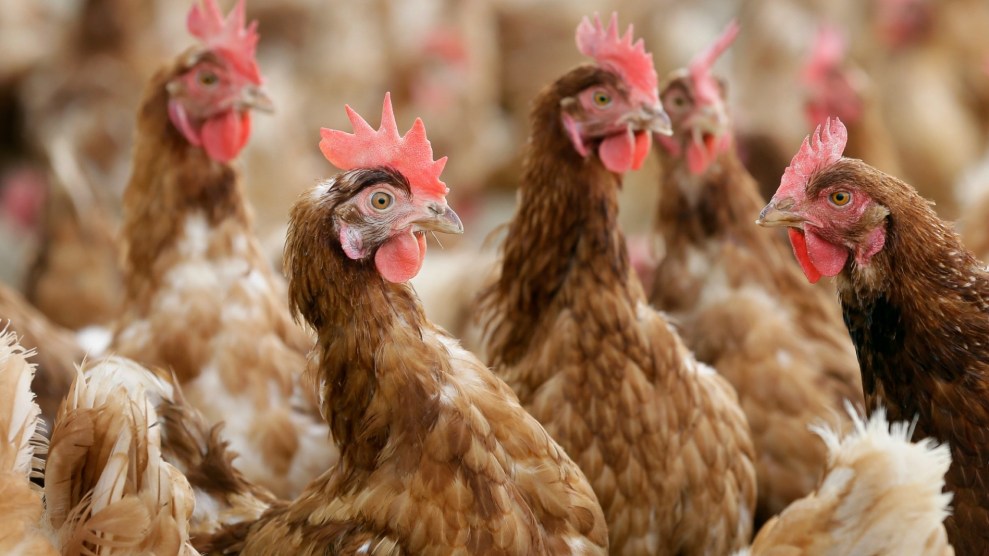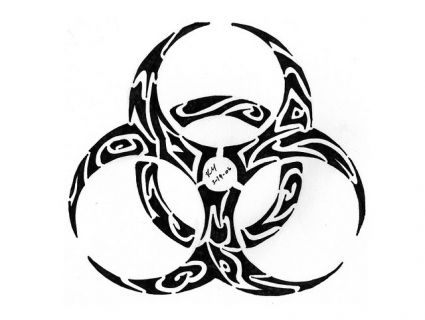
Charlie Neibergall/AP
This story was originally published by Wired and is reproduced here as part of the Climate Desk collaboration.
This month, the Cambodian government reported that two people there died of highly pathogenic avian influenza, or H5N1 bird flu, after being exposed to infected poultry. For people, the risk of getting infected is low, but outbreaks in animals have been rising worldwide, wiping out chicken flocks and wild bird populations. The virus is devastating to poultry producers, who are forced to slaughter infected flocks.
A growing number of countries are starting to vaccinate chickens against bird flu, while the United States and United Kingdom are still holding out because of uncertainties about immunization’s cost and effectiveness. Meanwhile, researchers in the UK have come up with another possible approach to protecting poultry flocks: gene editing. Scientists from the University of Edinburgh, Imperial College London, and the Pirbright Institute used the gene-editing tool Crispr to make the first chickens that are partially resistant to the virus. They published their results last week in the journal Nature Communications.
Like tiny molecular scissors, Crispr allows scientists to make targeted cuts to an organism’s genetic code. The UK team used the technology to tweak a chicken gene that is responsible for producing the protein ANP32A. During infection, the bird flu virus takes over this protein to help make copies of itself.
“All viruses are obligate parasites,” said Wendy Barclay, a study author and virologist at Imperial College London, during a press briefing on October 5. When viruses get inside a host cell, she said, “they hijack various proteins inside the cell to help themselves replicate.” In 2016, Barclay’s lab discovered that influenza viruses use the ANP32A protein in this way.
The researchers produced 10 chickens with this edited gene and exposed them to the H9N2 strain of bird flu, using a dose size that mimicked what animals would likely experience in the real world. They used this strain, rather than the more deadly H5N1, because it is the one chickens would most likely encounter during an outbreak. Only one of the 10 birds got infected, and the virus didn’t spread to other chickens.
The team then exposed the gene-edited birds to an artificially high dose of the virus. This time, five out of 10 birds became infected, but the gene edit still provided some level of protection. The amount of virus found in the infected animals was much lower than the level typically detected among chickens that are ill with bird flu.
The gene edit also helped limit the spread of the virus. Four ordinary chickens were placed in the same incubator with the gene-edited birds that had already been exposed to high levels of the virus. Out of the four, only one became infected.
Researchers monitored the gene-edited birds over the course of two years and found that the gene changes had no adverse effects on their health or egg production.
“This is showing a potential mechanism for reducing the susceptibility of chickens to avian flu,” says Carol Cardona, a veterinarian and professor of avian health at the University of Minnesota College of Veterinary Medicine, who wasn’t involved in the study. “But even if we protected every single chicken on the globe, flu wouldn’t go anywhere.” Avian influenza has been identified in more than 100 different species of birds.
The fact that some breakthrough infections occurred means that the virus still has a chance to infect other birds, and could “escape” the vaccine’s effects by mutating away from using the ANP32A protein to reproduce. In fact, when the UK researchers took samples of the virus from the infected gene-edited chickens, they found some mutations in the part of the virus that this protein interacts with. “The flu virus replicates rapidly, and every time it enters a new host, there’s an opportunity for that virus to adapt and change,” Cardona says.
During the press briefing, Barclay said those viral mutations didn’t make the chickens any sicker. The team also wanted to make sure those changes wouldn’t cause more severe infection in people, so they added the mutated viruses to human airway cells that had been cultivated in a dish. They found that the mutations didn’t help the virus grow in a way that would pose an increased risk to people.
It’s also not known how the gene-edited chickens will fare against the much more aggressive bird flu strains such as H5N1, which weren’t tested in the study. Barclay said they chose H9N2, considered a low pathogenicity virus that causes little to no signs of disease, in part because it’s more common. Also, deliberately infecting chickens with H5N1 raises animal welfare concerns, since it causes serious illness and is often fatal.
The authors identified two other related proteins, ANP32B and ANP32E, that they think would prevent virus replication. In chicken cells grown in the lab, they edited the genes that code for all three proteins and exposed them to the flu virus. The edits successfully blocked growth of the virus in the cells, but the researchers have not yet bred chickens with all three edits.
Susan Lamont, an expert on poultry genetics at Iowa State University, says that making multiple genetic modifications could reduce the possibility that the viruses will escape. “When you start doing that, it really makes it much more difficult for the virus population to find its way around the resistance properties of that animal,” she says.
But Brian Ladman, senior scientist at the University of Delaware Poultry Health System, says removing too many genes could be deleterious to the animals’ health. “These genes are there for a reason,” he says. For broiler chickens, which live only eight to 12 weeks before they are slaughtered, the health effects of gene editing may not have time to manifest during their lives, Ladman says. But laying chickens are kept commercially for two to three years.
While the research is still in very early stages and isn’t ready to be deployed widely, Lamont says she can imagine that future poultry producers may combine vaccination against avian flu with gene editing to boost viral resistance. “This disease is so prevalent and so important that any strategies that we can bring together to help protect the health of the birds is, in my view, very good,” she says.
Poultry producers already combine vaccination plus genetic selection—that is, choosing which chickens to breed based on certain traits—to prevent disease. Decades ago, scientists identified genetic variations that enhance resistance to the virus that causes Marek’s disease, a common and highly contagious illness that produces paralysis and tumors. Chicken producers began breeding birds with this trait while also vaccinating them against the disease. Lamont says this two-pronged approach is more protective than either on its own.
The UK researchers say their gene-edited chickens are a proof of concept that shows a possible way to make chickens resistant to bird flu. “We’re not there yet,” Barclay said. “We would need more edits, more robust edits to really shut down the virus replication.”
And in England at least, it will likely take some time for gene-edited chickens to make it to people’s plates. The government passed a law in March legalizing the commercial development of gene-edited foods, but a second vote is needed to allow farm animals with edited genomes. In the US, the first gene-edited food animal—a cow edited to have a short, slick-hair coat—was approved in 2022. The trait has been found to help cattle tolerate hot weather.











